A 2008 Transit/Transportation Planning Wish List for DC
AMNew York, the free daily in NYC published by Tribune Publishing, and unlike the Express, it is a publication with a lot of locally produced and generated stories about the city, has a story "MTA, commuter advocates offer transit wish list" about a 2008 transit wish list for the New York City region.
What would DC's transit/transportation/mobility wish list be? Here's a starter for me, and I apologize for its DC focus, and I am not going to address fare questions. While I am not happy about the price rise, given the cost situation, it wasn't unreasonable, and the base transit fares in the DC region are lower than other jurisdictions nationally.
If people want to write wish lists for other jurisdictions, please do so and send them to me and I'll post or link to them. Note that this list is not necessarily in order and for the most part I am not going to link to previous blog entries where I've written about these specific points in the past.
Funding
1. Creation of a transit withholding tax assessed on DC-based workers (70% of DC based workers do not live in the city). Depending on the rate, this could generate up to $250 million annually. Such a tax is assessed in certain counties in Oregon to support transit there. It would have to be used solely for transportation system improvements, and yes, that includes roads, but in the interim would likely be focused on transit improvements.
Note that this proposal for a transit withholding tax is separate from the Tom Davis initiative to match a $1.5 billion federal contribution to the WMATA system, in return for each of the jurisdictions creating a dedicated funding stream. A dedicated funding stream would merely protect the funding stream for current operations. The idea of a withholding tax is to fund system expansion and significant improvement.
• Transit in Washington, D.C.: Current Benefits and Optimal Level of Provision
• Washington's Metro: Deficits by Design (Brookings report)
Infrastructure Expansion
2. Commitment to the creation of the separated blue line subway in the center core of DC should be the number one priority for the use of this money including adding another NoVA tunnel crossing (which Virginia should help pay for). Maintaining and enhancing transit capacity in the core of the city is key to future competitiveness for the city.

3. and in building this line, consider double tunneling or adding a third track so that there can be express service and greater capacity than on the lines currently. (I don't understand why the WMATA system can't run trains as frequently as NYC subways can.)

Image: Tysons Tunnel
4. Create intra-neighborhood transit (bus) services so that people can get to and from local services, commercial districts, schools, libraries, and to and from transit stations. This includes delivery services of "freight" such as groceries. In my transportation and land use paper, I call this "tertiary" service (based on the Arlington model of the primary and secondary transit network, see their transportation plan). And it's not like we don't have a form of this now, at least within the city. Most neighborhoods have access to some bus service, although many people may not use it because it is circutuitous or because they feel that the bus service is beneath them.
5. Create a single railroad system for DC-MD-VA. Rather than having two separate systems oriented to commuters, although Maryland is in the process of transforming the MARC system to a 7 day system, with more service later in the evening, the region would be best served by one system that is vastly expanded. (Think of the equivalent of the Port Authority of New York and New Jersey but for the railroad system.) And connect MARC to SEPTA.

Dan Malouff's map of the core of a railroad system for Maryland, Virginia, and DC.
6. Pavement systems. Use pavement materials more selectively to manage driving speeds. Cars are engineered to go very fast. Roads are engineered to accommodate cars. Even though the posted speed on DC's major streets--the streets downtown and those through commercial districts and neighborhoods--is 25 mph, the actual pavement installed, concrete or asphalt, enables speeds of 50 mph to 100 mph, regardless of the surrounding context. Too often, people drive to the speed that streets and cars are capable, not to the speed that is appropriate for the context.
Change the road construction materials to match the desired speed conditions, particularly in neighborhoods. It would be the best traffic calming device there is. (I don't know if this can be done on roads that receive federal funding.)
Belgian block!
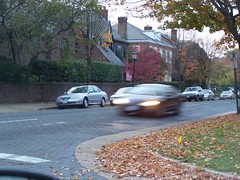
Belgian block on Monument Avenue, Richmond
Also see "The GOAL Project in Graz: Promotion of walking and cycling for the citizens' personal well being."
7. Yep, build out the streetcar network. Although there is the "hold up" of the fact that currently there is a law preventing overhead lines in the L'Enfant City. I think we need to take the time to see how the Alstom in-line power technology works out, and go for underground powering. But in the interim there is plenty to do...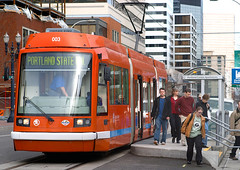
Streetcar at PSU Urban Studies Center. DC plans to use the same style of streetcar. Photo: Miles Hochstein, Portland Ground

Citadis train in Bordeaux with in-ground power. Photo from the Transit Coalition.
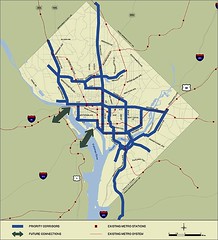
Originally proposed streetcar line map, DC.
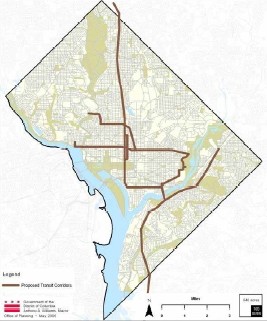
Streetcar Map with reduced number of lines as depicted in the DC Comprehensive Plan
8. DC is already rolling out new bus shelters and a bike rental system. Keep up the momentum, including more streetscape improvement projects, the creation of bicycle trails including the Metropolitan Branch Trail, etc.
9. Tunnelize the Metropolitan Branch railroad line. This is a stretch. It would cost billions and would involve creating tunnels for both the railroad and the subway. But it would allow for adding capacity to that line, which is quickly moving to capacity, and given that the subway line is bracketed by CSX railroad tracks, it can't expand except by having double stacked trains, which we can't do because of the way the tunnels and bridges exist.... (Note that a railroad, maybe CSX, maybe Norfolk Southern, is making their line from Chicago to Richmond capable of carry double stacked containers the whole route. This means adjusting tunnels and bridges...)
Note that this isn't a priority for me, but I think it should be listed nonetheless.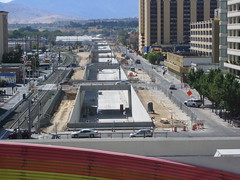
Tunnelizing the railroad in Reno, Nevada.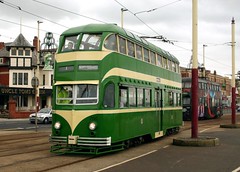
Double decker streetcar in England. Photo from Wikipedia. Hong Kong also has double decker streetcars.
System Improvement, including Marketing
10. Improve the bus service. I say do this before thinking about streetcars. We need to make bus service exciting and sexy, in order to boost transit use. I recommend better marketing and wayfinding systems, better bus shelters (coming) and waiting stations, and probably sexier buses, which to my way of thinking, would be double deckers, on routes that could accommodate them. Double deckers are 40 feet long, and more maneuverable than 60 foot articulated buses.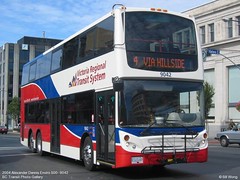
Double decker bus in Victoria, BC. Photo by Bill Wong.
11. Improve wayfinding and transit information. It's not bad, but could be a lot better, and transit stations need to be better utilized as "touchpoints" for marketing the use of the transit system, especially for tourists. Bus shelters are a key place for this especially.
Arlington has information systems for transit that it places in office buildings and public places. Portland and Seattle have extensive transit information systems placed in major public buildings and gathering places (city hall, colleges, libraries, public markets).
12. Improve marketing. I don't want to go into this, but for the most part transit in the region is promoted in a very stodgy way. Shake things up... Start by changing the graphic design scheme of the buses and Metro signage. Make the buses and signage pop graphically as much as the map already does.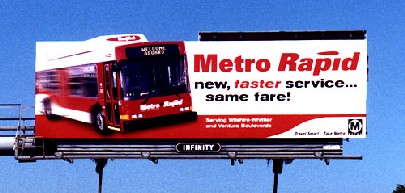
Los Angeles has done some interesting transit promotional marketing. But we need to do the same kind of marketing in office buildings, public places, hotels, and transit stations.
13. I don't believe that transit needs to be free. Many clamor for such. But cost isn't the biggest barrier to using transit. And places like Portland have the Fareless Square--funded in part by their transit withholding tax. But I think that equity issues make a downtown oriented fareless square somewhat unfair as the biggest beneficiaries would be the people with jobs downtown, who tend to not be those with the greatest need.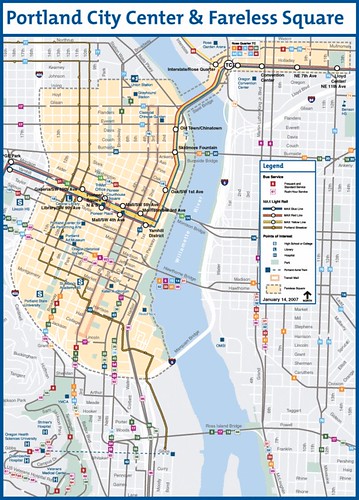
However, in my paper I suggest that the intra-neighborhood transit services (tertiary transit network) could be free. I estimate this would cost maybe $30 million annually.
Transportation Planning
14. Create a transportation plan for the city that isn't wimpy, that addresses parking and curbside management, makes transportation demand management and planning the baseline standard, that sets a goal of reducing the number of single occupancy vehicle trips in the city.
Arlington County's plan is a good model, with separate sections on infrastructure, transit, parking and curbside management, pedestrians, and bicycling.
15. Linking transportation and land use planning in DC by revising the approach of zoning to mobility-access-land use planning, along the lines of the Dutch "accessibility planning" method. See "Utrecht: 'ABC' Planning as a planning instrument in urban transport policy." This means that uses are not considered equal in all places in a zoning district, that uses are mapped to places where transportation demand and transportation supply are in equilibrium and/or maximized, but accommodated without significant degradation.
And in the interim, make the Department of Transportation planning unit a part of the process in Board of Zoning Adjustment and Zoning Commission matters. Right now, BZA blows off reports from DDOT. They should be a required part of the process and considered just as important as the staff reports provided by the Development Review division of the Office of Planning.
16. Create transportation management districts centered around key commercial districts, and stressing transportation demand management planning, shared parking systems, time shifting freight delivery, shared delivery services for consumers, and include accommodations for bicyclists (lockers, showers, racks on the street, etc.), among other things. Have parking meter revenues go to the TMDs rather than the City's General Fund, for neighborhood-based mobility enhancement.
17. Do a parking study of the entire city, comparable to what Seattle did, and change requirements accordingly, including a paradigm of shared parking systems in commercial districts. As a result, Seattle eliminated parking requirements in certain areas, including around transit stations, stating:
Lower parking requirements based on local demand and to support alternative transportation. In Urban Centers and high capacity transit station areas, allow the market rather than the code to determine appropriate parking supply.
18. Speaking of parking and curbside management, change the residential parking permit system in DC to one that emphasizes the privilege, rather than the right, to park.
a. Residential parking permits should cost a lot more generally. As you probably know, Prof. Shoup estimates that the value of the public space on the street is about $1800 annually.
b. There should be a limit on how many residential parking permits can be issued per household. Only one car can fit in front of a typical rowhouse. Multiple cars per household should be discouraged.
c. The rate for residential parking permits should go up considerably for each additional permit per household address.
d. Parking permit rates should be weighted according to how large a car is, and its carbon footprint (maybe). One of the big problems I'd say anecdotally is that people in the city may only be buying one car, but it is much much larger than it used to be (an SUV). This further reduces available parking inventory for residents.
e. Maybe charge the current rate for a Smart Car, but a minimum of $100 (I'd say higher...) for the next largest car. Even a Mini is 12 feet long, and a Beetle is 14 feet long. So the "smallest" cars still take up an entire rowhouse width in terms of length, when you figure space between cars.
Bigger issues
19. Increase the gasoline excise tax at the national level, as well as at the state level in DC, MD, and VA.
20. Somehow, and this would be best done nationally, eliminate free parking. As long as people can park for free, it will be difficult for transit to compete, because people do not calculate the sunk cost of a car into their calculations for the cost of driving vs. transit. Still, for transit to be competitive it means that the system needs to be dense and efficient in order for trips to be quick.
21. Somehow, the composition of the WMATA board needs to be addressed. I am not sure that having a separately elected board is the right way to go, because since the system is funded by individual jurisdictions, you want those people participating. But the fact is that there isn't enough long range planning and advocacy going on, and many of the decisions made are very political, rather than being oriented to maintaining and extending the best possible transit system that the region can achieve.
Hmm, what did I leave out?
Note that I think all of these things are far more important than looking at congestion charges, or putting tolls on the bridges, or related distractions. And as far as DC is concerned, the Purple Line isn't a key priority. Neither is the southern leg of a Purple Line (from New Carrollton to Alexandria). Although both are extremely important in terms of regional transportation planning.
Labels: transit, transportation planning



2 Comments:
Much thanks to you for giving such significant data, and a debt of gratitude is for sharing this Business Promotion system.
Thank you for putting this together I would like to know if any of your Wishlist came true as the years have passed.
Post a Comment
<< Home